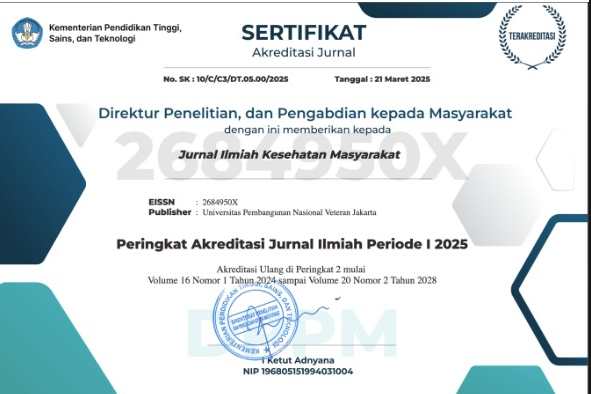Gambaran Gaya Hidup Kurang Gerak (Sedentary Lifestyle) dan Berat Badan Remaja Zaman Milenial di Tangerang, Banten
Abstract
Latar belakang: Remaja zaman now (milenial) merupakan masa yang dipengaruhi oleh kecanggihan ilmu dan teknologi sehingga adanya dorongan berperilaku kurang gerak atau kurang aktivitas fisik. Gaya hidup remaja yang kurang gerak atau kebiasaan tidak banyak melakukan aktivitas fisik merupakan gaya hidup yang santai, seperti duduk, berbaring, membaca, menonton televisi, bermain mobile phone dikenal dengan sedentary lifestyle ini banyak terjadi di daerah perkotaan dan lebih sering terjadi pada perempuan. Pamulang merupakan area padat penduduk dan mempunyai banyak sekolah menengah pertama.
Metode: Penelitian ini dilakukan di SMPM Pamulang dari bulan April-Juli 2019, yang bertujuan untuk memberikan gambaran bagaimana remaja putri tingkat sekolah menengah menghabiskan waktunya dalam 24 jam. Jumlah sampel pada penelitian ini berjumlah 103 orang dengan teknik pengambilan sampel total sampling. Namun, hanya 94 remaja yang dapat dianalisis. Pengambilan data menggunakan instrumen sedentary life style yang sudah terstandar internasional. Penelitian deskriptif kuantitatif ini menggunakan analisa univariat.
Hasil: Hasil penelitian ini menunjukkan persentase terbanyak gaya hidup remaja yang kurang gerak <2 jam dalam 24 jam (rendah) adalah 77,7%, yang menggunakan waktunya untuk kegiatan yang kurang gerak 2-4 jam (sedang) adalah 17,7%, yang menghabiskan waktu untuk kegiatan kurang gerak >4 -6 jam bahkan lebih (tinggi) adalah 5,3%. Obesitas hanya 10,63%.
Kesimpulan: Hasil ini diharapkan dapat menjadi data dasar bagi peneliti selanjutnya terkait upaya promotif dan preventif perilaku dan gaya hidup remaja yang sehat dalam mencegah penyakit ataupun masalah yang diakibatkan oleh sedentary life style yang tinggi seperti obesitas, gangguan kesehatan lainnya.
Kata kunci: gaya hidup kurang gerak, remaja, obesitas
Description of Adolescents Sedentary Lifestyle, Obesity in Junior High School, Tangerang Selatan AbstractBackground: Adolesecence is a transitional periode. The problem that is often appear in adolescent is obesity. Obesity can be influenced by a lifestyle that lacks activity or movement called the sedentary lifestyle. Purpose: The study aims to provide a description of the adolescent sedentary lifestyle and weight in yunior high school Tangerang Selatan.
Methods: The sampling technique in this study was total sampling and from 103 adolescence who signed informed concent and fill the quesioner, only 94 adolescences complete the study. The research design used in this study was descriptive quantitative. Collecting data used instrument of sedentary lifestyle has been tested as international standard. Univariate analysis used the proportion test.
Results: The results of the current study described that adolescent whose sedentary lifestyle <2 hours in 24 hours is 77, 7%, whose sedentary lifestyle 2 to 4 hours is 17.7% and whose sedentary lifestyle >4 to 6 hours or more is 5.3%. The participants whose obesity is 10.63%. This results is expected to be useful for researchers, SMPM Tangerang Selatan, and faculty of science UPNVJ to be the basic data for further study on the promotion and preventive efforts of adolescens reproductive health.
Conclusions: This study have described the sedentary lifestyle of adolesecent to be the basic data for further research.
Keywords: Sedentary lifestyle, adolescent, obesity
References
Setyoadi S, Ika SR, Triana N. Hubungan penggunaan waktu perilaku kurang gerak (sedentary behavior) dengan obesitas. Jurnal Ilmu Keperawatan, 2015; 3(2): 68- 80
Septi VK, Toto S, Lely L. Physical activity and sedentary lifestyle towards teenagers’ overweight/obesity status. International Journal of Community Medicine and Public Health, 2016; 3(3):630–635. https://doi.org/10.18203/2394- 6040.ijcmph20160623
Retno M, Muhammad S, Nissa C. Sedentary Lifestyle sebagai Risiko Kejadian Obesitas pada Remaja SMA Stunted di Kota Semarang. Journal of Nutrition College, 2017; 6(2): 149–155. https://doi.org/http://dx.doi.org/10.1101/0 27409
Mark ST, Salome A, Joel DB, Travis JS, Valerie C, Amy LC, Sebastien FMC, Teatske MA, Mai JMC, ... Sedentary Behavior Research Network (SBRN) - Terminology Consensus Project process and outcome. International Journal of Behavioral Nutrition and Physical Activity. 2017;14(75): 1-17 DOI 10.1186/s12966-017-0525-8
Kemenkes. Basic Health Research . 2013 ( 6). https://doi.org/1 December 2013
Nur A, Tetti S, Titin S. Gambaran Faktor
– faktor yang Berhubungan dengaN Perilaku Seksual Pranikah pada Remaja di SMPN 1 Solokanjeruk Kabupaten Bandung. Jurnal Pendidikan Keperawatan Indonesia. 2018. 4(2); 131-9.
Alfia D. Hubungan Penggunaan Smartphone dengan Perilaku Seksual Remaja di SMAN X Jember. Jurnal Ilmu Keperawatan. 2016; 1-12
DP2KBP3A. Bidang Ketahanan dan Kesejahteraan Keluarga yang menangani Kesehatan Reproduksi. 2017
Ratna D, Ratna D. Faktor - faktor yang Berhubungan dengan Perilaku Seksual Pranikah pada Remaja SMPN Negeri 1 Talang Empat Kabupaten Benkulu Tengah. Jurnal IKESMA, 2015; 11(10).
Friedman, Marilyn M . Buku Ajar Keperawatan Keluarga : Riset, Teori, dan Praktek. Jakarta : EGC. 2010.
Desmawati, Waraporn K, Warangkana C. Effect of nursing intervention integrating Islamic praying program on labor pain and pain behaviors in nulliparous Muslim women. Iranian Journal of Nursing Midwifery Research, 2019; 24(3): 62-68.









.jpg)








